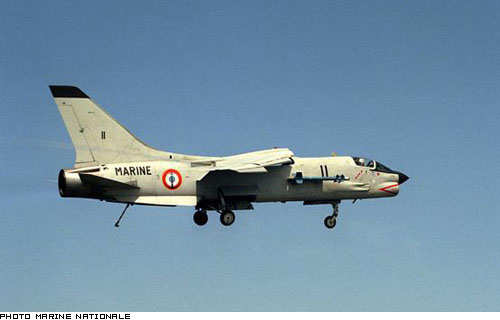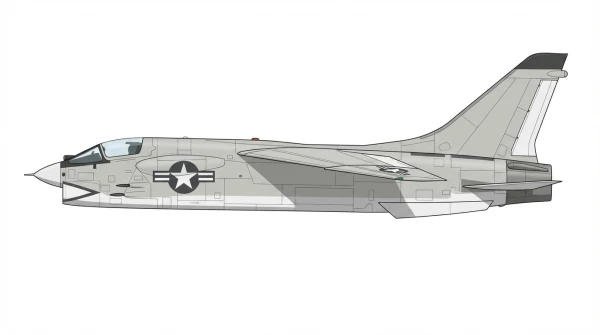F-8 Crusader
Summary
| Category | Combat Aircraft |
| Origin country | 🇺🇸 United States |
| Manufacturer | Vought |
| First flight | 25 March 1955 |
| Year introduced | 1957 |
| Number produced | 1219 units |
| Average unit price | $2.5 million |
Description
Development of the F-8 Crusader began following a United States Navy requirement issued in September 1952 for a new fighter aircraft. Vought's design team created the V-383, a fighter featuring a high-mounted variable-incidence wing, an area-ruled fuselage, all-moving stabilators, dog-tooth notching at the wing folds, and extensive use of titanium. In June 1953, Vought received an initial order for three XF8U-1 prototypes. The first prototype flew on 25 March 1955. Flight testing proved relatively problem-free. On 21 August 1956, U.S. Navy pilot R.W. Windsor reached 1,015 mph, making the F-8 the first American jet fighter to exceed 1,000 mph.
A key feature of the F-8 was its variable-incidence wing. It pivoted 7° out of the fuselage during takeoff and landing, allowing for a greater angle of attack and increased lift without compromising forward visibility. Lift was augmented by leading-edge flaps drooping 25° and inboard flaps extending 30°. The F-8 incorporated contemporary aerodynamic innovations such as an area-ruled fuselage, all-moving stabilators, and dog-tooth notching at the wing folds for improved yaw stability. Liberal use of titanium was made throughout the airframe. Power was provided by a single Pratt & Whitney J57 turbojet engine with an afterburner.
The F-8 Crusader's armament was centered around four 20 mm (.79 in) Colt Mk 12 autocannons, making it the final U.S. fighter designed with guns as its primary weapon. The original design included a retractable tray with 32 unguided Mk 4/Mk 40 Folding-Fin Aerial Rockets (Mighty Mouse FFARs), but this was later sealed shut as the rockets were never used operationally. The cannons were supplemented by cheek pylons capable of carrying four guided AIM-9 Sidewinder air-to-air missiles. In practice, Sidewinder missiles became the F-8's primary weapon, largely due to the unreliability of the 20mm guns; nearly all of the aircraft's aerial victories were achieved using Sidewinders. Upgraded variants, such as the F-8E, had their payload capacity increased to 5,000 lb (2,270 kg) and could carry a variety of ordnance, including rockets, air-to-surface missiles like the AGM-12 Bullpup, and bomb configurations such as eight 250 lb Mark 81 bombs or two 2,000 lb Mark 84 bombs on underwing pylons.
The F-8 Crusader was introduced into regular US Navy operations in March 1957. It was operated by the US Navy, Marine Corps (where it replaced the Vought F7U Cutlass), French Navy, and Philippine Air Force. Early service indicated the F-8 was not an easy aircraft to fly and experienced an above-average mishap rate. American F-8s saw combat during the Vietnam War, engaging in dogfights with MiG-17s of the Vietnam People's Air Force and performing ground attack missions. The photo-reconnaissance RF-8 Crusader variant played a role in the Cuban Missile Crisis by providing low-level photographs of Soviet medium range ballistic missiles (MRBMs) in Cuba. Several modified F-8s were used by NASA for experimental flights, including testing digital fly-by-wire technology and supercritical wing design. The RF-8 operated in U.S. service longer than any of the fighter versions, with the United States Navy Reserve withdrawing its remaining aircraft in 1987.
Main Variants:
-
F8U-1 (F-8A): The first production version of the Crusader, it was powered by a J57-P-12 engine, later upgraded to the more powerful J57-P-4A starting with the 31st aircraft.
-
F8U-1E (F-8B): This variant introduced a limited all-weather capability with the addition of the AN/APS-67 radar, and its unguided rocket tray was sealed shut due to lack of operational use.
-
F8U-2 (F-8C): Featuring a J57-P-16 engine with increased afterburning thrust, it included ventral fins for yaw stability and Y-shaped cheek pylons for Sidewinder missiles, later retrofitted with AN/APQ-83 radar.
-
F8U-2N (F-8D): An all-weather version with the unguided rocket pack replaced by an additional fuel tank, it featured a J57-P-20 engine, an automatic landing system, and the AN/APQ-83 radar.
-
F8U-2NE (F-8E): This version was equipped with a J57-P-20A engine, AN/APQ-94 radar in a larger nose cone, a dorsal hump for AGM-12 Bullpup missile electronics, increased payload, and a Martin-Baker ejection seat.
Technical specifications
| Version: F-8E | |
|---|---|
| Crew | 1 pilot |
| Operational range | 730 km (454 mi) |
| Maximum speed | 1971 km/h (1225 mph) |
| Wing area | 34.8 m² (374.6 sqft) |
| Wingspan | 10.9 m (35.7 ft) |
| Height | 4.8 m (15.7 ft) |
| Length | 16.5 m (54.2 ft) |
| Service ceiling | 17,678 m (57,999 ft) |
| Empty weight | 7,956 kg (17,540 lbs) |
| Max. takeoff weight | 13,000 kg (28,660 lbs) |
| Climb rate | 162.3 m/s (532.5 ft/s) |
| Powerplant | 1 x turbojet Pratt & Whitney J57-P-20A delivering 4853 kgf each |
Current operating countries
All operators
Armament
Missiles payload:
- Air-to-Air Medium-Range Bisnovat R-98 (AA-3 Anab)


